AC/DC Electric-Field-Assisted Growth of ZnO Nanowires for Gas Discharge
Abstract
1. Introduction
2. Materials and Methods
2.1. Method of Applying AC and CD Electric Fields
2.2. Method of Growing ZnO Nanowires on Microelectrodes
2.3. Method of Growing ZnO Nanowires on PCBs
3. Results and Discussions
3.1. Requirement of Gas Discharge for ZnO Nanowires
3.2. Growth of ZnO Nanowires on Microelectrodes
3.3. Growth of ZnO Nanowires on PCBs
4. Conclusions
Author Contributions
Funding
Institutional Review Board Statement
Informed Consent Statement
Data Availability Statement
Conflicts of Interest
References
- Zhang, Y.; Ram, M.K.; Stefanakos, E.K.; Goswami, D.Y. Synthesis, Characterization, and Applications of ZnO Nanowires. J. Nanomater. 2012, 2012, 624520. [Google Scholar] [CrossRef]
- Baskoutas, S. Special Issue: Zinc oxide nanostructures: Synthesis and characterization. Materials 2018, 11, 873. [Google Scholar] [CrossRef] [PubMed]
- Özgür, Ü.; Alivov, Y.I.; Liu, C.; Teke, A.; Reshchikov, M.A.; Doğan, S.; Avrutin, V.; Cho, S.-J.; Morkoç, H. A comprehensive review of ZnO materials and devices. J. Appl. Phys. 2005, 98, 041301. [Google Scholar] [CrossRef]
- Park, S.; An, S.; Jin, C.; Lee, C. Dependence of the gas sensing properties of ZnO nanowires on their microstructure. Appl. Phys. A 2012, 108, 35–40. [Google Scholar] [CrossRef]
- Chen, X.; Wong, C.K.Y.; Yuan, C.A.; Zhang, G. Nanowire-based gas sensors. Sens. Actuators B Chem. 2013, 177, 178–195. [Google Scholar] [CrossRef]
- Andres, G.M.; Guillermo, S.; Frank, G.; Paulina, R.M.A.; Ateet, D. Photoluminescence of ZnO nanowires: A Review. Nanomaterials 2020, 10, 857. [Google Scholar]
- Zong, X.; Zhu, R. ZnO nanorod-based FET biosensor for continuous glucose monitoring. Sens. Actuators B Chem. 2018, 255, 2448–2453. [Google Scholar] [CrossRef]
- Zhu, R.; Wang, D.; Xiang, S.; Zhou, Z.; Ye, X. Zinc oxide nanowire electromechanical oscillator. Sens. Actuators A Phys. 2009, 154, 224–228. [Google Scholar] [CrossRef]
- Taborowska, P.; Wasiak, T.; Sahlman, M.; Lundström, M.; Janas, D. Carbon nanotube-based thermoelectric modules enhanced by ZnO nanowires. Materials 2022, 15, 1924. [Google Scholar] [CrossRef]
- Manzano, C.V.; Philippe, L.; Serra, A. Recent progress in the electrochemical deposition of ZnO nanowires: Synthesis approaches and applications. Crit. Rev. Solid State Mater. Sci. 2022, 47, 772–805. [Google Scholar] [CrossRef]
- Yang, W.; Zhu, R.; Zong, X. ZnO nanowire-based corona discharge devices operated under hundreds of volts. Nanoscale Res. Lett. 2016, 11, 90. [Google Scholar] [CrossRef]
- Yang, W.; Zhu, R.; Zong, X. A MEMS based discharger using nanowires. In Proceedings of the 13th IEEE International Conference on Nanotechnology (IEEE-NANO 2013), Beijing, China, 5–8 August 2013; pp. 360–365. [Google Scholar]
- Park, C.W.; Lee, S.G.; Kim, M.O.; Kim, J.; Hwang, J. Development and performance test of a ZnO nanowire charger for measurements of nano-aerosol particles. Sens. Actuators A Phys. 2015, 222, 1–7. [Google Scholar] [CrossRef]
- Bogaerts, A.; Neyts, E.; Gijbels, R.; van der Mullen, J. Gas discharge plasmas and their applications. Spectrochim. Acta Part B At. Spectrosc. 2002, 57, 609–658. [Google Scholar] [CrossRef]
- Yang, W.; Zhu, R.; Wang, L.; Liu, B. Charging efficiency of nanoparticles in needle-to-plate chargers with micro discharge gaps. J. Nanopart. Res. 2019, 21, 125. [Google Scholar] [CrossRef]
- Modi, A.; Koratkar, N.; Lass, E. Miniaturized gas ionization sensors using carbon nanotubes. Nature 2003, 424, 171–174. [Google Scholar] [CrossRef] [PubMed]
- Zhang, Y.; Liu, J.; Zhu, C. Novel gas ionization sensors using carbon nanotubes. Sens. Lett. 2010, 8, 219–227. [Google Scholar] [CrossRef]
- Sadeghian, R.B.; Islam, M.S. Ultralow-voltage field-ionization discharge on whiskered silicon nanowires for gas-sensing applications. Nat. Mater. 2011, 10, 135–140. [Google Scholar] [CrossRef] [PubMed]
- Sadeghian, R.B.; Kahrizi, M. A novel miniature gas ionization sensor based on freestanding gold nanowires. Sens. Actuators A Phys. 2007, 137, 161–169. [Google Scholar] [CrossRef]
- Cui, J.B. Zinc oxide nanowires. Mater. Charact. 2012, 64, 43–52. [Google Scholar] [CrossRef]
- Xing, X.; Zheng, K.; Xu, H.; Fang, F.; Shen, H.; Zhang, J.; Zhu, J.; Ye, C.; Cao, G.; Sun, D.; et al. Synthesis and electrical properties of ZnO nanowires. Micron 2006, 37, 370–373. [Google Scholar] [CrossRef]
- ElZein, B.; Yao, Y.; Barham, A.S.; Dogheche, E.; Jabbour, G.E. Toward the growth of self-catalyzed ZnO nanowires perpendicular to the surface of silicon and glass substrates, by pulsed laser deposition. Materials 2020, 13, 4427. [Google Scholar] [CrossRef] [PubMed]
- Wan, Q.; Yu, K.; Wang, T.H.; Lin, C.L. Low-field electron emission from tetrapod-like ZnO nanostructures synthesized by rapid evaporation. Appl. Phys. Lett. 2003, 83, 2253–2255. [Google Scholar] [CrossRef]
- Rusli, N.I.; Tanikawa, M.; Mahmood, M.R.; Yasui, K.; Hashim, A.M. Growth of high-density zinc oxide nanorods on porous silicon by thermal evaporation. Materials 2012, 5, 2817–2832. [Google Scholar] [CrossRef]
- Vayssieres, L. Growth of Arrayed nanorods and nanowires of ZnO from aqueous solutions. Adv. Mater. 2003, 15, 464–466. [Google Scholar] [CrossRef]
- Liu, Z.; Zhu, R.; Zhang, G. Electric-field-assisted growth and alignment of ZnO nanowires in device fabrication. J. Phys. D Appl. Phys. 2010, 43, 155402. [Google Scholar] [CrossRef]
- Yang, W.; Zhu, R.; Zong, X. Continuous corona discharge using nanowires. In Proceedings of the 4th International Conference on Manipulation, Manufacturing and Measurement on the Nanoscale (3M-NANO), Taipei, Taiwan, 27–31 October 2014; pp. 143–147. [Google Scholar]
- Wang, D.; Zhu, R.; Zhou, Z.; Ye, X. Controlled assembly of zinc oxide nanowires using dielectrophoresis. Appl. Phys. Lett. 2007, 90, 103110. [Google Scholar] [CrossRef]
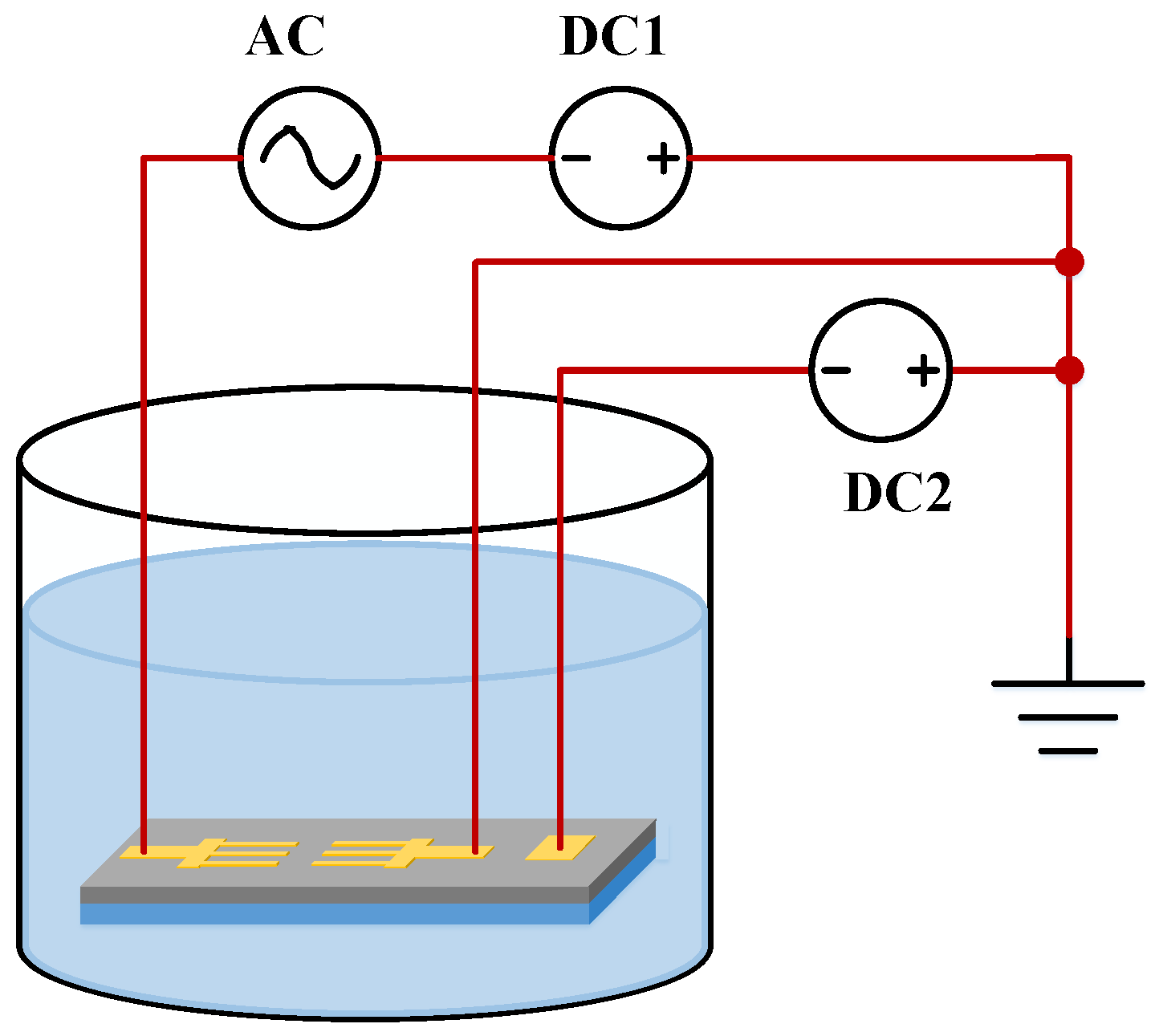

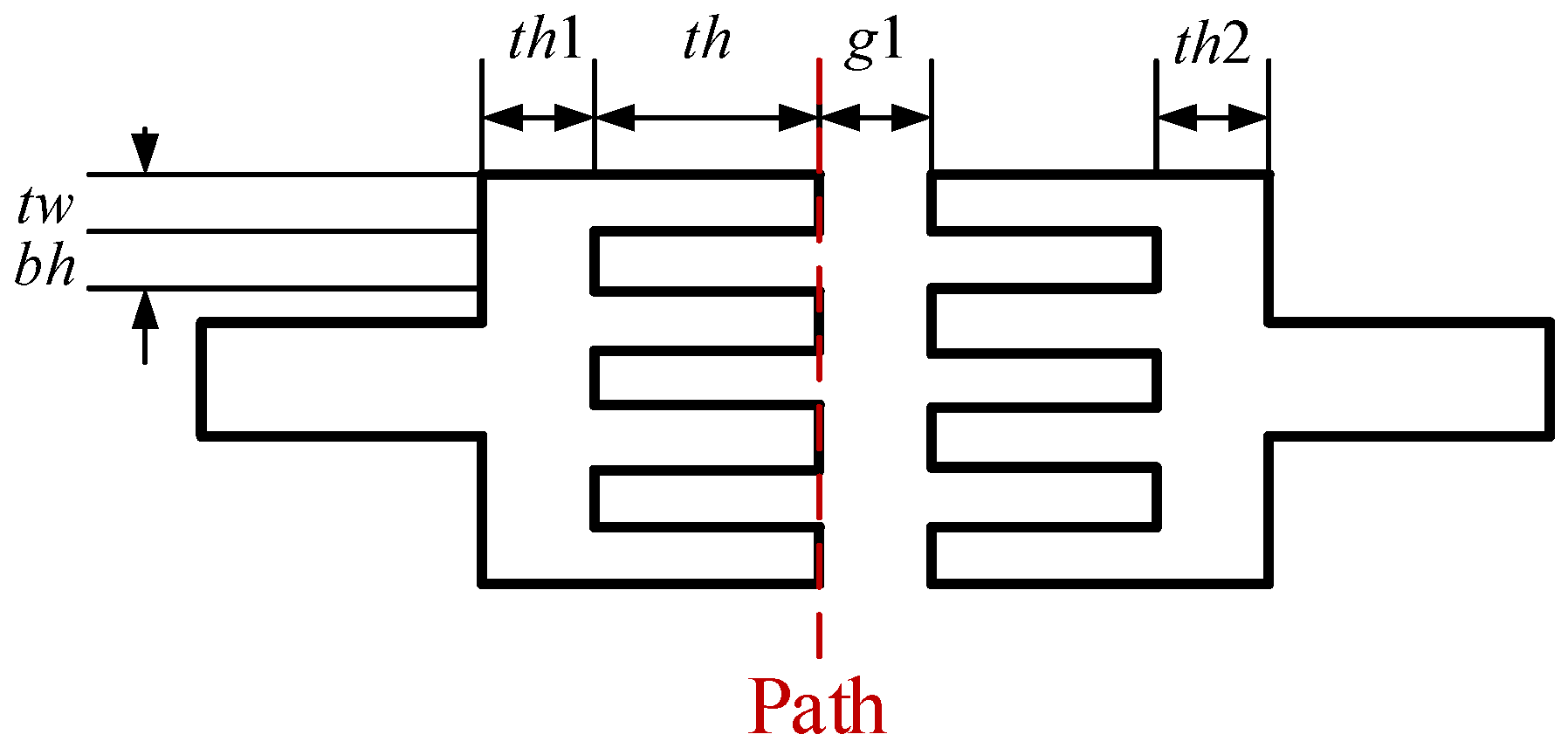
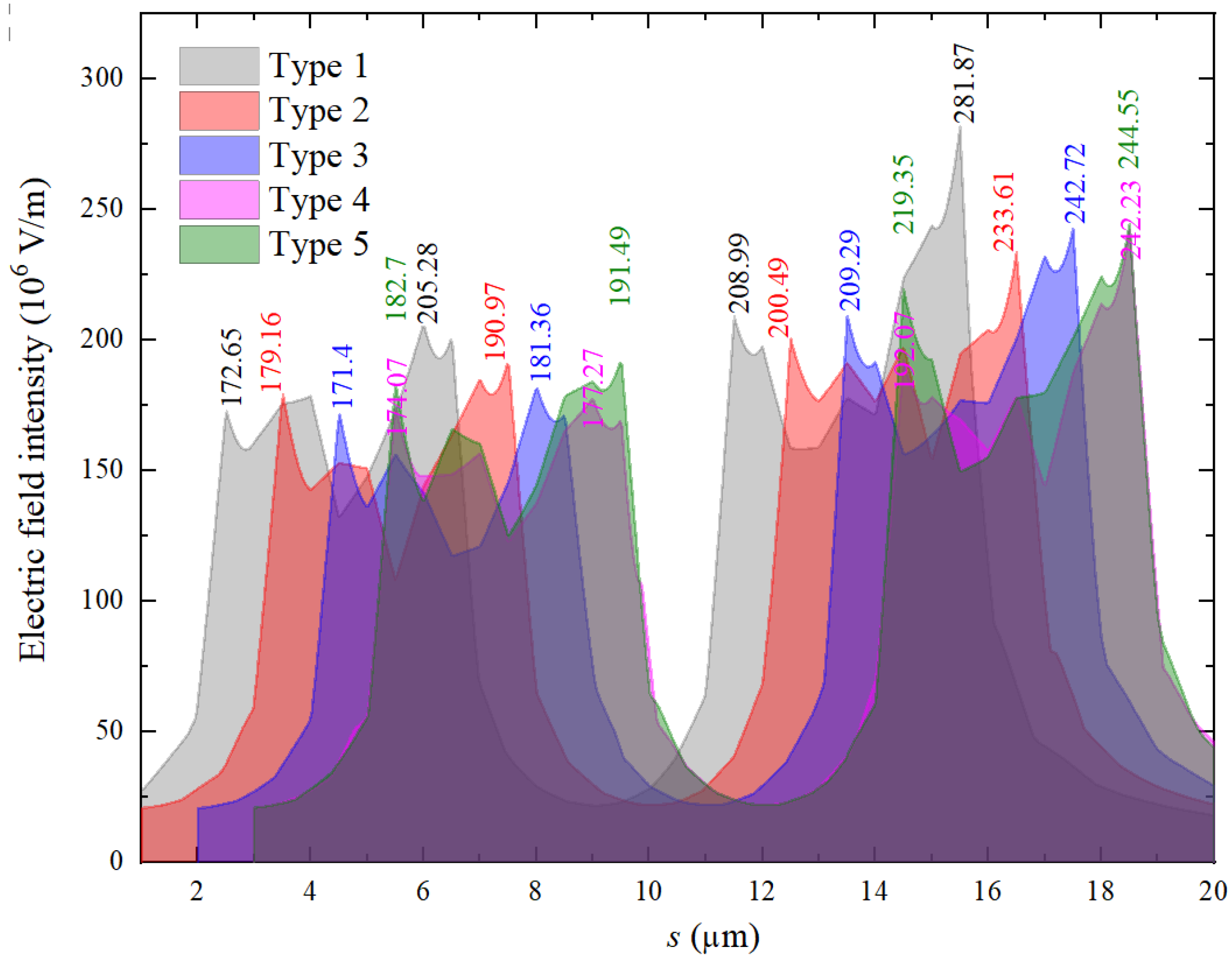
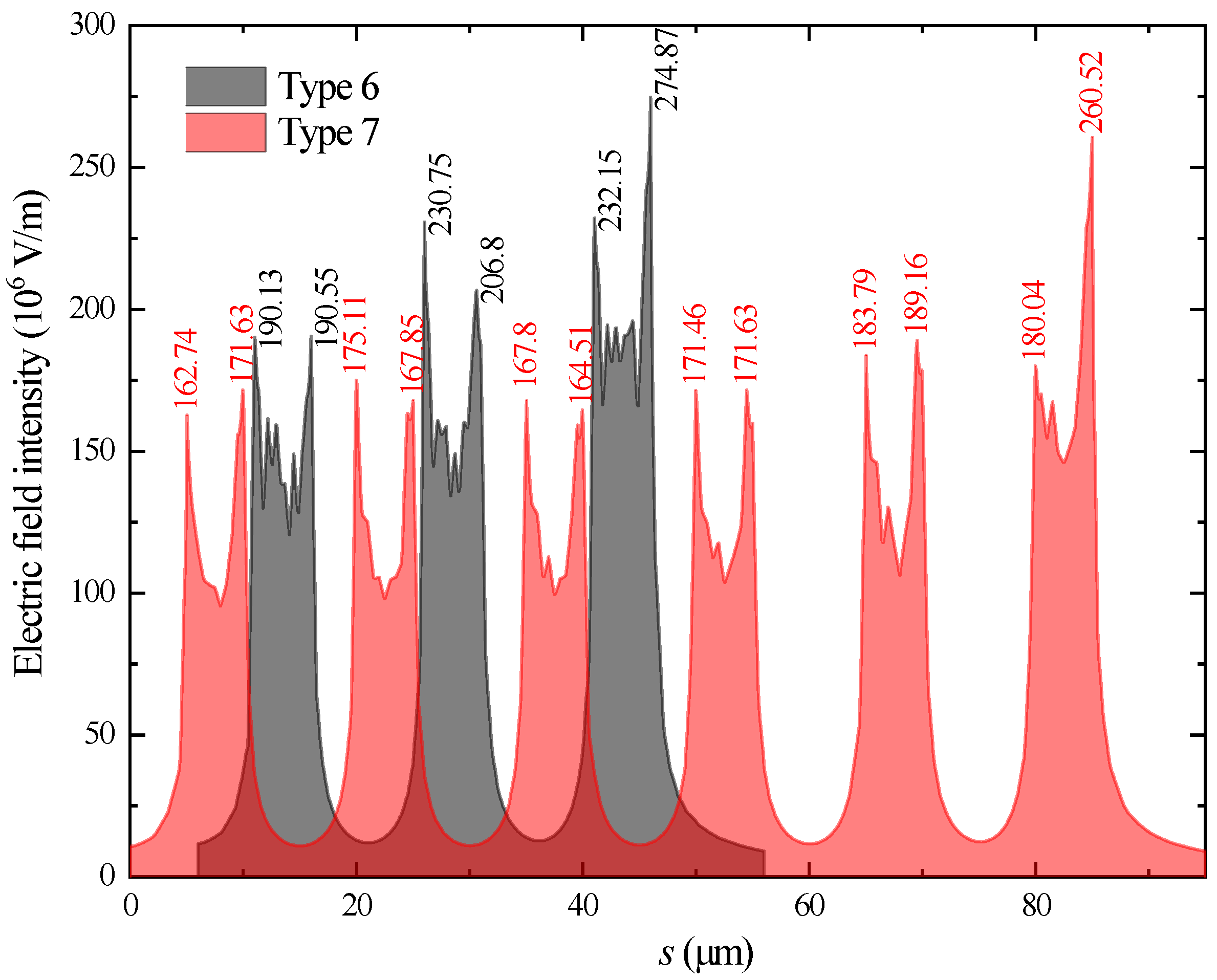

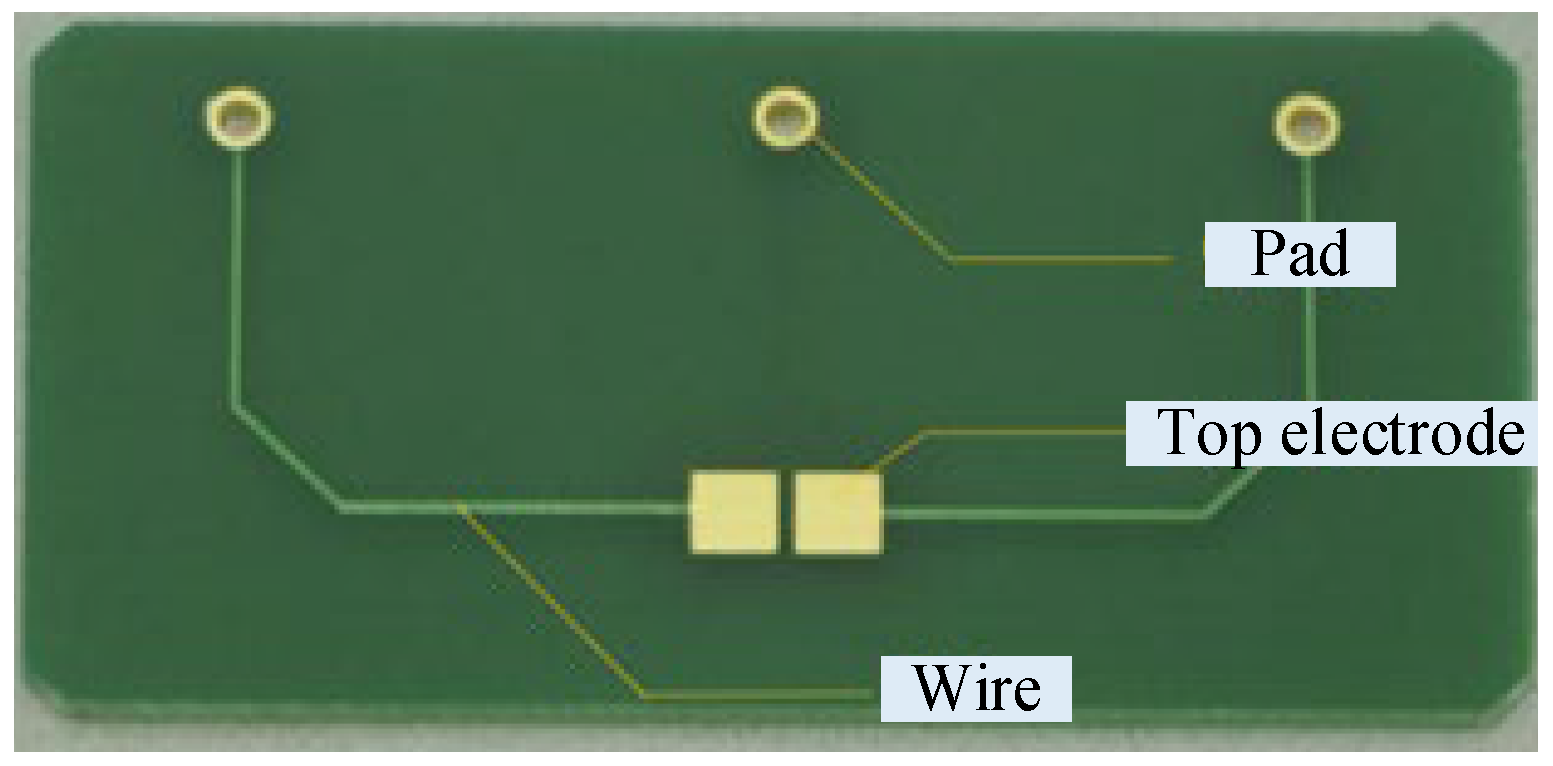

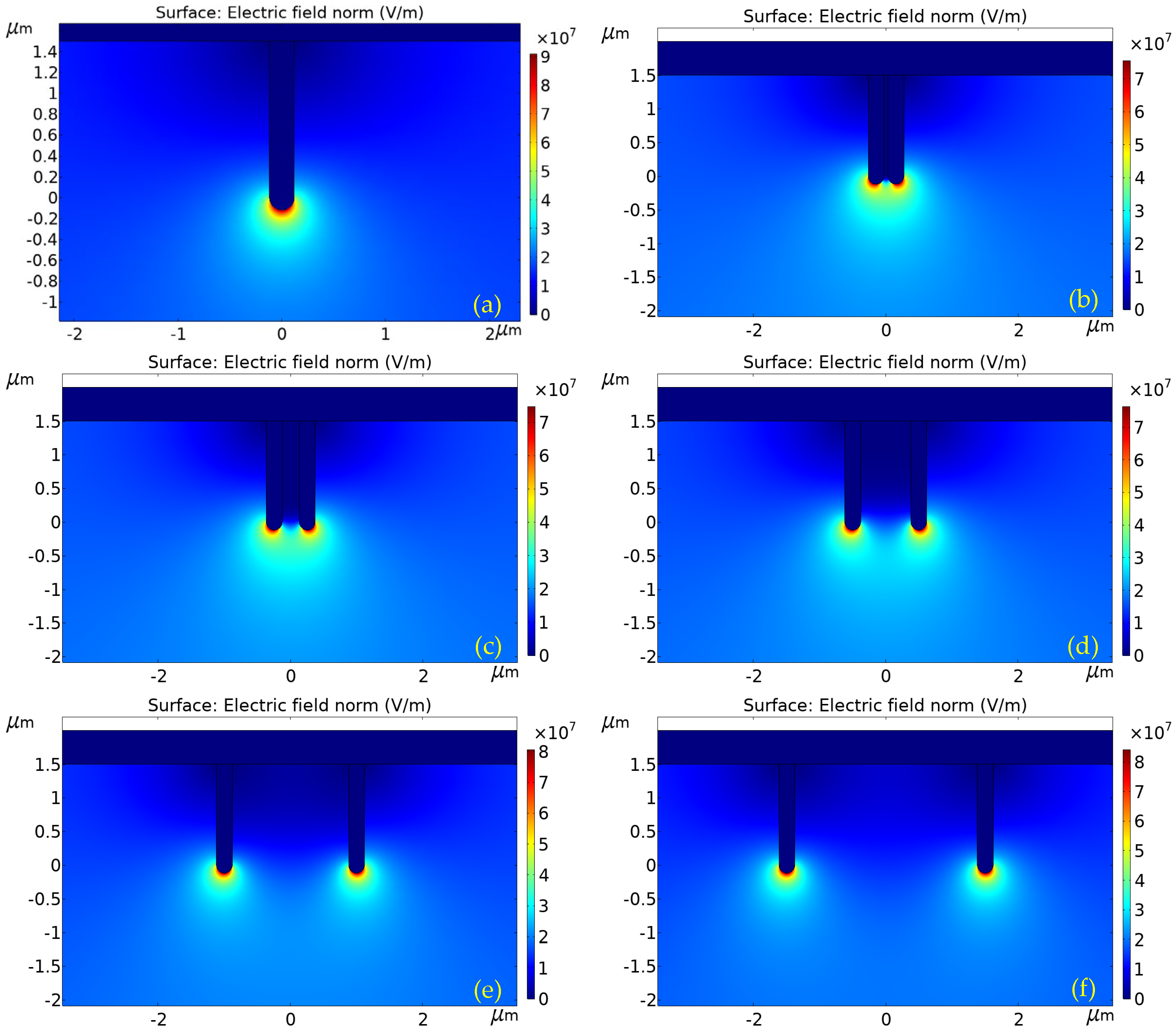
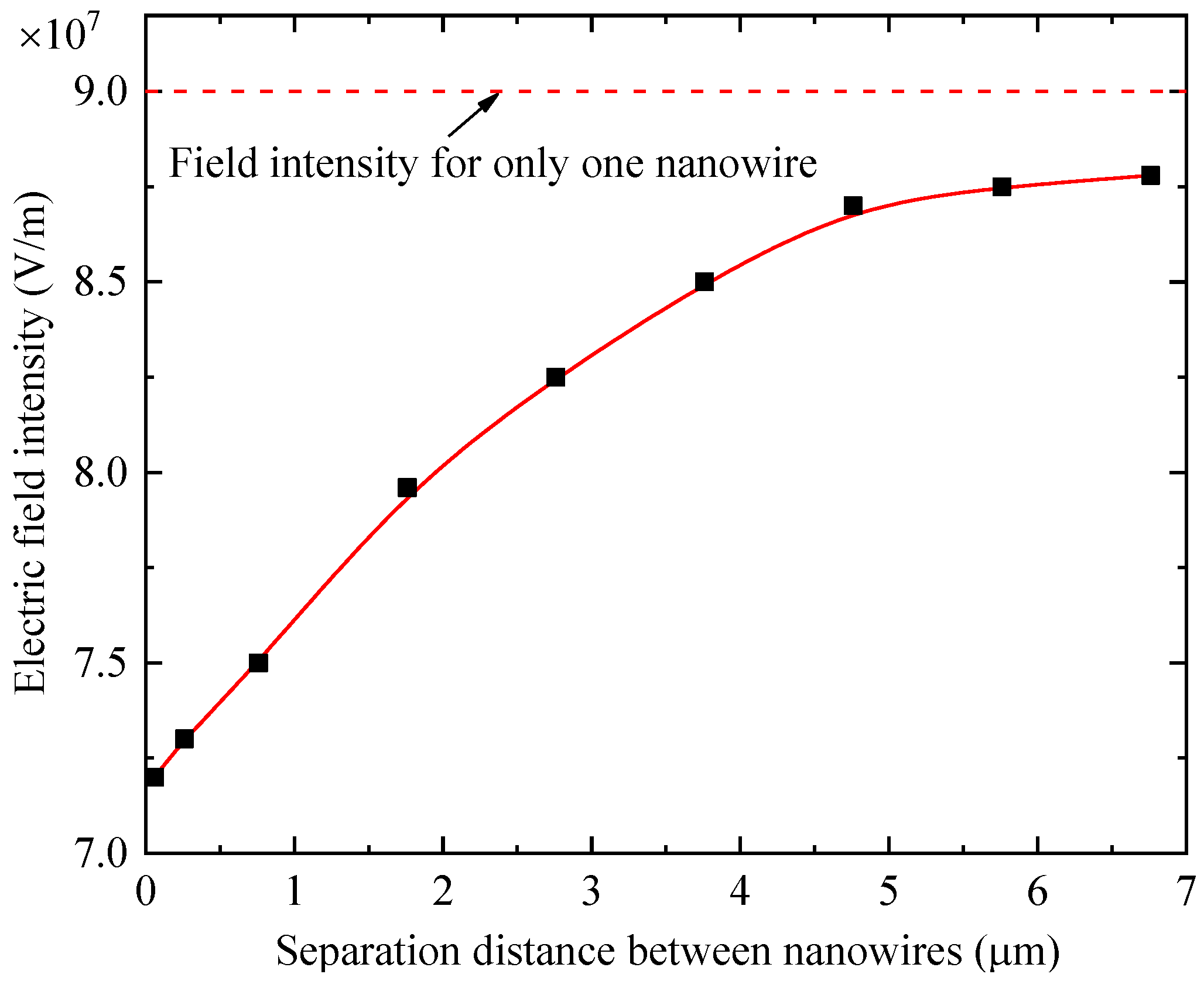
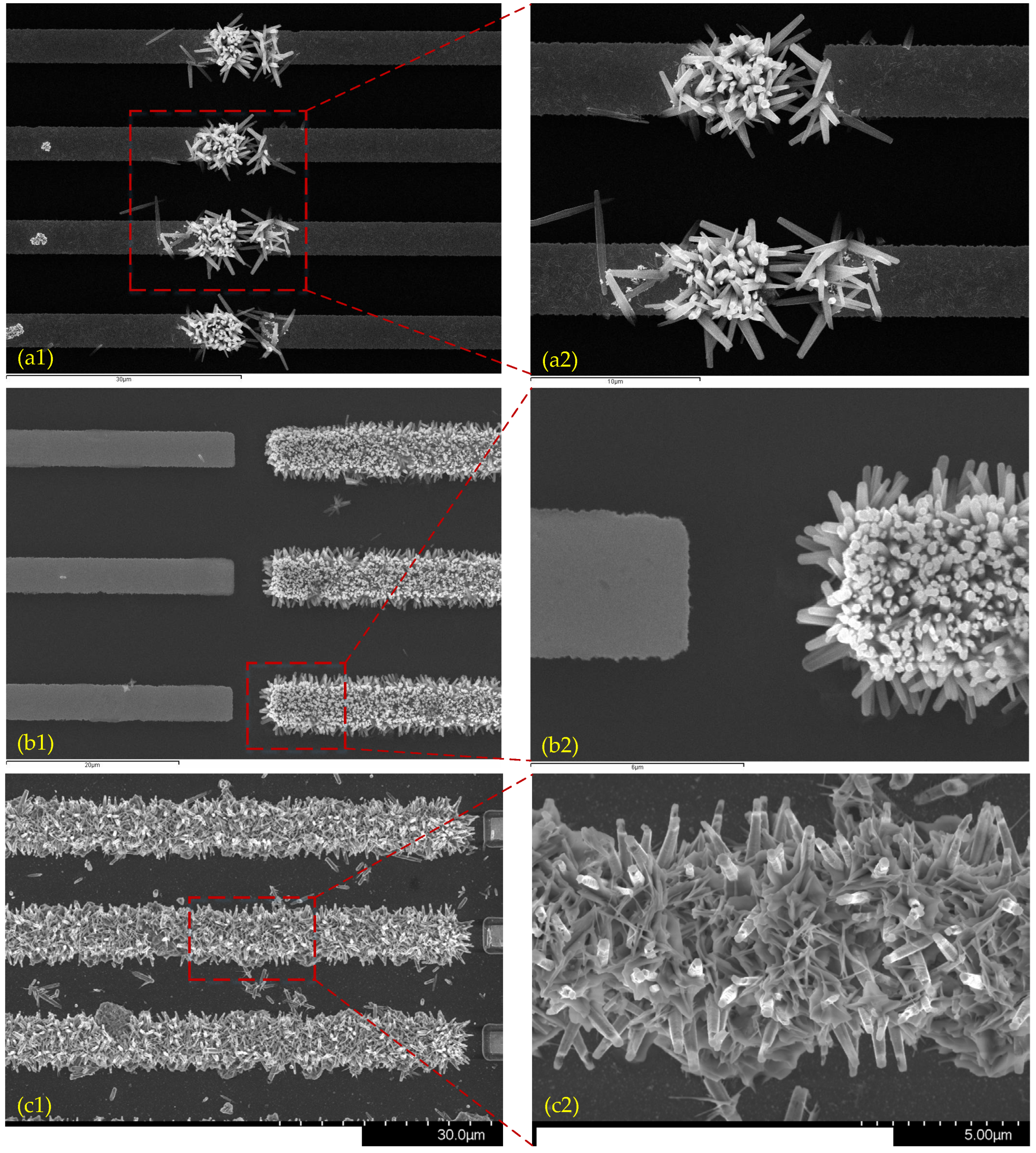
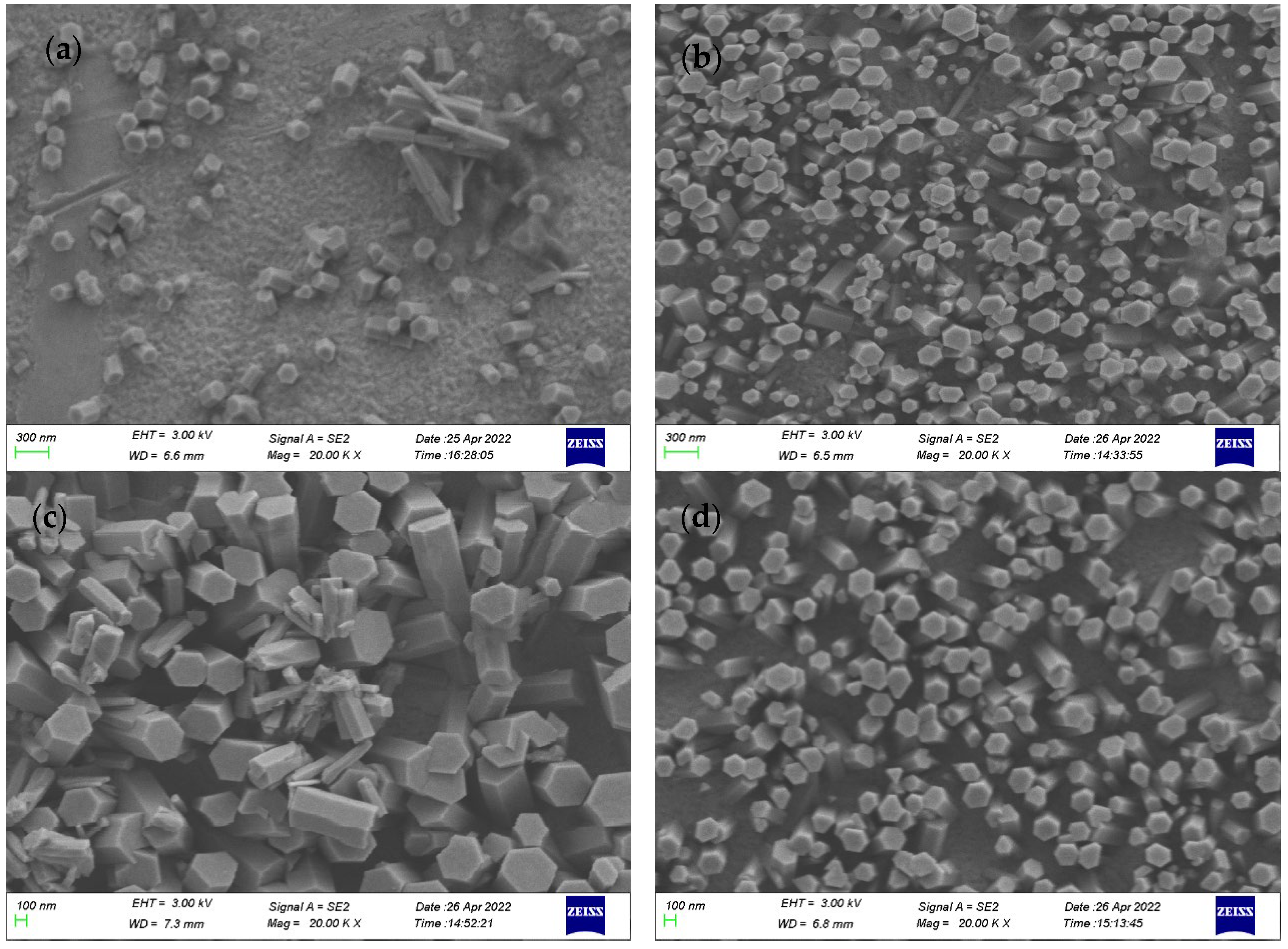
| Number | g1/μm | tw/μm | bh/μm | th/μm | Number of Tips |
|---|---|---|---|---|---|
| Type 1 | 1 | 4 | 5 | 20.5 | 4 |
| Type 2 | 2 | 4 | 5 | 20 | 4 |
| Type 3 | 3 | 4 | 5 | 19.5 | 4 |
| Type 4 | 4 | 4 | 5 | 19 | 4 |
| Type 5 | 5 | 4 | 5 | 18.5 | 4 |
| Type 6 | 4 | 5 | 10 | 70 | 6 |
| Type 7 | 4 | 5 | 10 | 70 | 12 |
| Number of Nanowires | Distance between Nanowires (μm) | (×107 V/m) |
|---|---|---|
| 1 | - | 9.08 |
| 2 | 0.06 | 7.21 |
| 2 | 0.26 | 7.26 |
| 2 | 0.76 | 7.51 |
| 2 | 1.76 | 7.96 |
| 2 | 2.76 | 8.25 |
Disclaimer/Publisher’s Note: The statements, opinions and data contained in all publications are solely those of the individual author(s) and contributor(s) and not of MDPI and/or the editor(s). MDPI and/or the editor(s) disclaim responsibility for any injury to people or property resulting from any ideas, methods, instructions or products referred to in the content. |
© 2022 by the authors. Licensee MDPI, Basel, Switzerland. This article is an open access article distributed under the terms and conditions of the Creative Commons Attribution (CC BY) license (https://creativecommons.org/licenses/by/4.0/).
Share and Cite
Yang, W.; Hao, C.; Zhang, S.; Zheng, T.; Zhu, R.; Liu, B. AC/DC Electric-Field-Assisted Growth of ZnO Nanowires for Gas Discharge. Materials 2023, 16, 108. https://doi.org/10.3390/ma16010108
Yang W, Hao C, Zhang S, Zheng T, Zhu R, Liu B. AC/DC Electric-Field-Assisted Growth of ZnO Nanowires for Gas Discharge. Materials. 2023; 16(1):108. https://doi.org/10.3390/ma16010108
Chicago/Turabian StyleYang, Wenming, Chenjun Hao, Shengsen Zhang, Tianyang Zheng, Rong Zhu, and Beiying Liu. 2023. "AC/DC Electric-Field-Assisted Growth of ZnO Nanowires for Gas Discharge" Materials 16, no. 1: 108. https://doi.org/10.3390/ma16010108
APA StyleYang, W., Hao, C., Zhang, S., Zheng, T., Zhu, R., & Liu, B. (2023). AC/DC Electric-Field-Assisted Growth of ZnO Nanowires for Gas Discharge. Materials, 16(1), 108. https://doi.org/10.3390/ma16010108





